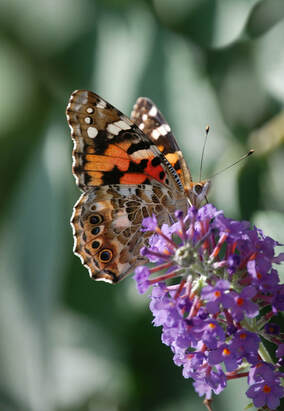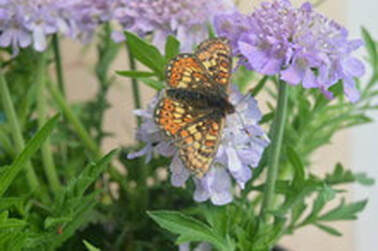 Painted Lady on Buddleja
Painted Lady on Buddleja
Natives Versus Exotics
Danger of Exotics Becoming Invasive
Buddleja is a favourite nectar source for our long-tongued Peacock and Small-Tortoiseshell butterflies, as well as the migratory Painted Lady. But should we be growing invasive aliens like this?
In contrast to native wild flowers, it's often the case with exotics that none of our native insects have evolved to eat them. With so few insects to keep them in check there is a risk that if they survive our climate they might get out of hand.
Buddlejas despite their merits, are an obvious example. In many parts of the country they are choking out our native species. This is especially noticeable along large stretches of railway line where they now predominate to the exclusion of a wider variety of native hedgerow plants that grew there previously.
The nectar they provide may be good for long-tonged bumble bees and adult butterflies but they fail to provide the all-important leaves for caterpillars, and the larvae of other species.
Exotics May Have Their Place
Despite the reservations, if you already have good nectar sources like Buddleja, Verbena and other exotics growing in your garden they may be worth hanging on to.
The spectacle of the flower heads of Sedum spectabulae covered with Small Tortoiseshells is unforgettable. Non-invasive exotics like this Sedum may be useful for supplementing nectar levels at times and in areas where there are currently not enough wildflowers to supply the demand.
Starting from scratch though it is much better to go for native plants rather than potentially invasive exotic ones. The aim should always be to build up the numbers of nectar-producing wildflowers so that exotics are not needed.
In Praise of Native Wild Flowers
The great virtue of a native wild flower is that it will be the larval foodplant, if not of a butterfly, then certainly of other types of insect. Not all of the native plants in your greenspace or garden even need to provide pretty flowers. Why should they, when the less flamboyant species are likely to support equally important populations of invertebrates, and are just as good for biodiversity. Many people with less concern for the environment are content with blocks of concrete, so I’m sure we can welcome a few flowerless leafy wildflowers into our gardens.
